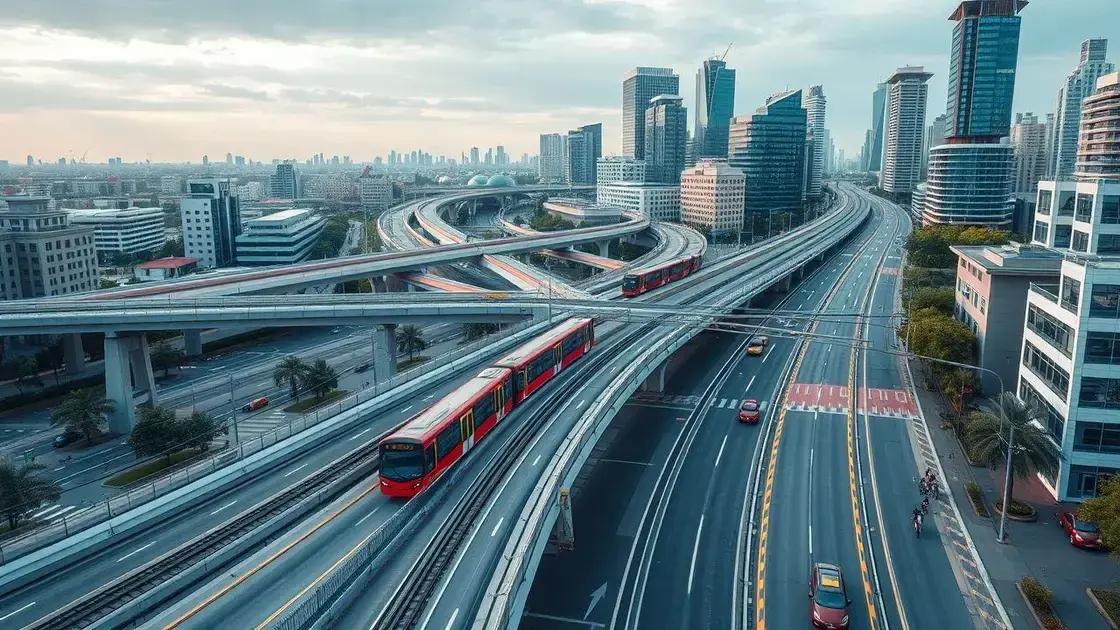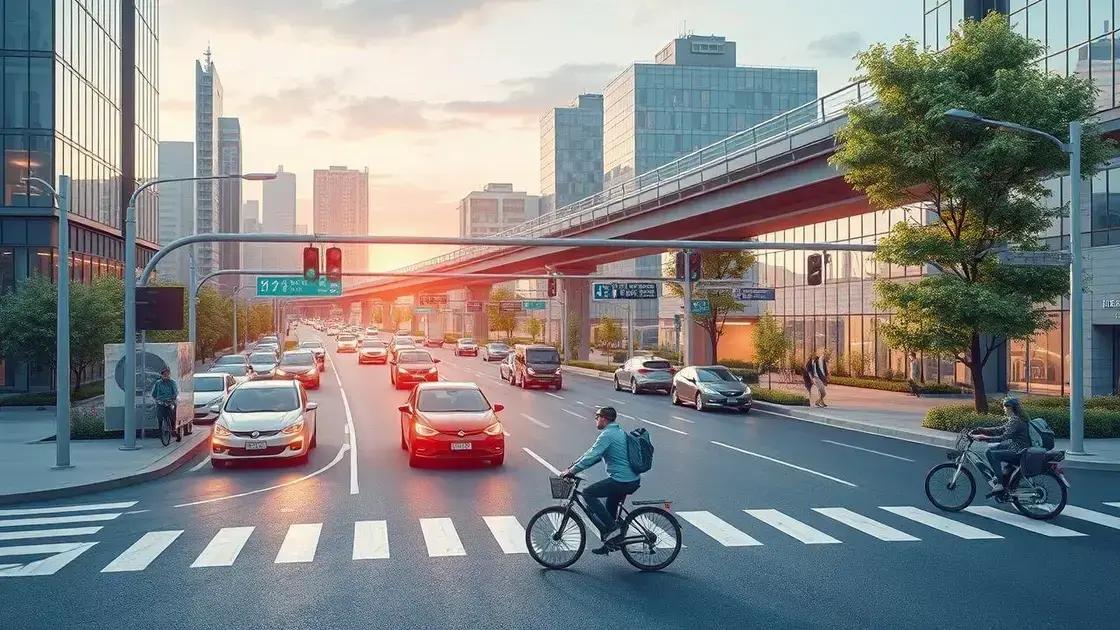New transportation infrastructure projects approved: what you need to know

New transportation infrastructure projects approved enhance mobility, promote sustainability, create jobs, and integrate smart technology to improve urban living and environmental conditions.
New transportation infrastructure projects approved promise to transform our daily commutes and connectivity. Have you thought about how these changes might enhance your travel experience? Let’s explore what’s in store.
Overview of recent transportation infrastructure projects
Recent transportation infrastructure projects are making a significant impact across the country. These initiatives are designed to improve connectivity and enhance the quality of life for residents.
Key Features of New Projects
One major aspect of these projects is their focus on sustainability. Many new infrastructures, such as bike lanes and public transit systems, aim to reduce traffic congestion and promote eco-friendly travel options. This shift benefits not just drivers, but also pedestrians and cyclists.
Funding Sources
The funding for these initiatives often comes from various sources, including federal grants, state budgets, and private investments. Understanding where the money comes from helps us appreciate the scale and ambition of these projects.
- Federal transportation grants support major projects.
- State governments allocate budgets for local improvements.
- Private investments can enhance public transport systems.
- Public-private partnerships are becoming more common.
As these new transportation infrastructures are developed, communities are more connected than ever before. Residents can expect improved commutes and increased accessibility to essential services. Additionally, these projects often create local jobs, contributing to economic growth while enhancing mobility.
Looking forward, we can anticipate even more advancements in transportation infrastructure. Smart technology integration, such as traffic management systems and real-time transit updates, will further improve user experiences. The focus on multimodal transportation will create a seamless experience for all users, whether they drive, cycle, or walk.
Key benefits of these new transportation initiatives

The key benefits of these new transportation initiatives are numerous and impactful. They aim to improve not only how we travel but also the environment we live in.
Improved Mobility
One of the primary advantages is the enhancement of mobility for all citizens. With new transit options, people can move more freely between neighborhoods and cities.
- Increased access to public transport reduces reliance on personal vehicles.
- New bike lanes provide safer routes for cyclists.
- Walking paths encourage a healthier lifestyle.
- Access to real-time transit information aids in better planning of commutes.
Moreover, these projects typically lead to reduced congestion on roads. Fewer cars on the streets mean less time spent in traffic. This change not only makes travels more efficient but also reduces stress for daily commuters.
Environmental Impact
Another significant benefit is the positive impact on the environment. Many of these initiatives prioritize sustainability and aim to lower carbon footprints. For instance, expanding public transportation options encourages people to use them rather than driving alone.
With fewer emissions from vehicles, air quality improves, leading to healthier living conditions in urban areas. Moreover, the development of green spaces along transportation routes promotes ecosystem health and biodiversity.
Additionally, these transportation projects create job opportunities. Construction work, maintenance, and operations require a workforce, which contributes to local economies. By investing in new infrastructure, communities stimulate job creation in both short and long-term scenarios.
Lastly, these initiatives often enhance the overall quality of life. Residents gain better access to education, healthcare, and employment opportunities, resulting in more vibrant and connected communities. With smoother travel and improved accessibility, daily life can become more enjoyable for everyone.
How funding is allocated for infrastructure projects
Understanding how funding is allocated for infrastructure projects is crucial for grasping their impact on communities. This funding shapes the future of transportation and related developments.
Sources of Funding
Funding originates from various sources. Federal government grants are among the largest contributors. These grants often support major projects that span several states or regions. State budgets also play a significant role as local governments allocate money based on their unique needs.
- Federal grants provide significant support for large infrastructure initiatives.
- State funding is tailored to meet local needs.
- Public-private partnerships are increasingly utilized.
- Local taxes may contribute to funding at the community level.
Moreover, public-private partnerships are becoming more popular. These collaborations allow private companies to invest in infrastructure while receiving a return on their investment. This approach leads to innovation, as private entities bring new ideas and technologies to the table.
Budgeting Process
The budgeting process for these projects involves thorough planning and community input. Officials must prioritize initiatives based on factors like traffic congestion and safety concerns. Engaging the community helps ensure that the needs and desires of residents are considered before final decisions are made.
Each project typically undergoes a detailed assessment, including cost-benefit analyses. This ensures resources are allocated efficiently to maximize impact. By carefully evaluating each initiative, cities can secure funding for projects that provide the greatest benefits.
Additionally, grants may be tied to specific goals, such as environmental standards or job creation. As requirements fluctuate, the allocation of funds must adapt accordingly, ensuring that projects align with both local and national priorities.
Future trends in transportation infrastructure development

Future trends in transportation infrastructure development are focused on sustainability and technological advancements. These trends are reshaping the way we view transportation.
Smart Transportation Systems
One major trend is the rise of smart transportation systems. These systems use technology to improve the flow of traffic and enhance user experiences. For example, traffic signals that adjust based on real-time traffic data help reduce congestion.
- Real-time updates keep commuters informed.
- Traffic management systems optimize travel routes.
- Connected vehicles communicate with infrastructure.
- Smart traffic lights enhance safety and reduce wait times.
The incorporation of artificial intelligence (AI) will also play a vital role. AI can analyze data to improve public transport efficiency and manage resources better. This integration leads to increased reliability for users.
Eco-Friendly Developments
Sustainability is another critical focus. Cities are prioritizing eco-friendly materials and technologies. Infrastructure projects now include green roofs, permeable pavements, and renewable energy sources. These innovations help lessen the environmental impact of new developments.
Moreover, urban planning is evolving to prioritize walkability and cycling. This shift encourages healthier lifestyles, reduces vehicle reliance, and fosters community interaction. The increased availability of bike lanes and pedestrian pathways creates inviting spaces for all.
Additionally, investments in electric vehicle (EV) charging stations are becoming more common. As more people adopt electric vehicles, having adequate charging infrastructure is essential for supporting this shift.
As cities move towards a more integrated approach, the transportation systems of the future will reflect a blend of technology and sustainability, responding to the needs of communities and the environment alike.
FAQ – Frequently Asked Questions about New Transportation Infrastructure Projects
What are the key benefits of new transportation infrastructure projects?
The key benefits include improved mobility, sustainability, job creation, and enhanced community engagement.
How is funding allocated for transportation infrastructure projects?
Funding comes from federal grants, state budgets, and public-private partnerships, with careful planning and community input involved.
What role does technology play in the future of transportation infrastructure?
Technology, especially smart systems and AI, enhances traffic management, improves public transport efficiency, and creates safer travel conditions.
How do infrastructure projects impact the environment?
These projects prioritize eco-friendly materials and practices, aiming to reduce carbon footprints and promote healthier urban living conditions.






